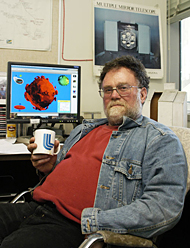- Number 286 |
- May 11, 2009
LLNL's Dearborn explores asteroid 'nudge'

David Dearborn
As if there’s not enough to worry about—the sinking economy, spiking unemployment and the likely consequences of climate change—add to this a remote possibility of an asteroid or comet with an unusual orbit crashing into the Earth.
It’s a subject that David Dearborn, a research physicist at DOE's Lawrence Livermore National Laboratory, takes very seriously, even though he recognizes that only a few of these bodies actually could present a potential hazard.
Dearborn, whose work at the Lab has included the design and testing of both nuclear and conventional explosives, leads a team that is modeling the impact of a nuclear explosion on an object’s trajectory in space.
He believes that nuclear explosives are the best bet for deflecting unwanted asteroids and near-Earth objects (NEOs) into a more harmless path by using what he terms a “nudge” or gentle change in the object’s orbit.
Explosions could modify the direction and speed of a potentially dangerous space object, yet not threaten Earth.
Dearborn first became interested in the possibility of using nuclear capabilities to deflect incoming asteroids in 2003, when, because of his background in astronomy and astrophysics, he was asked to work with the Planetary Defense Conference.
Dearborn demonstrates an enthusiastic passion for science. His conversation is quick and focused. And, you might catch him searching for a white board, so he can better illustrate a point.
Prior to joining LLNL in 1983, he was an assistant professor at the University of Arizona. But he left academia for a simple reason: “I wanted to do research.”
Dearborn’s future research involves using a supercomputer to simulate the effect of nudging an asteroid with a small nuclear explosion—less than one kiloton delivered one meter below its surface.Submitted by DOE's Lawrence Livermore National Laboratory
